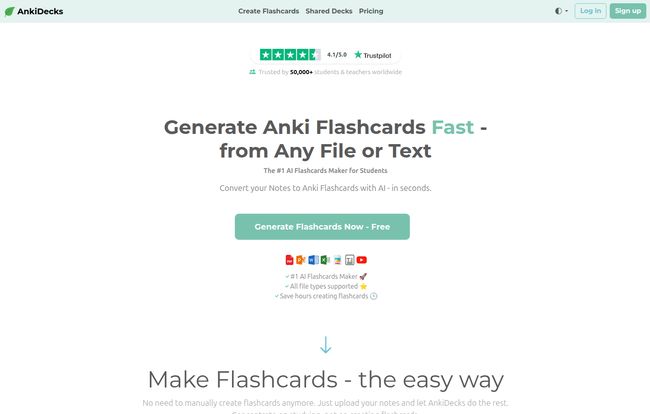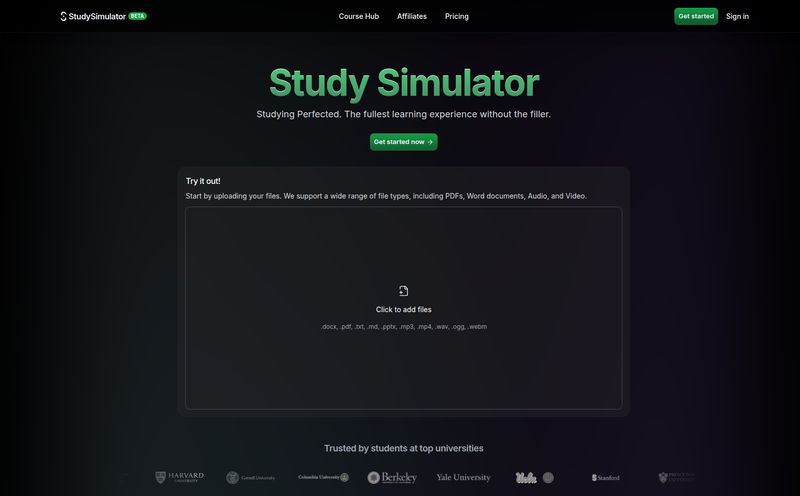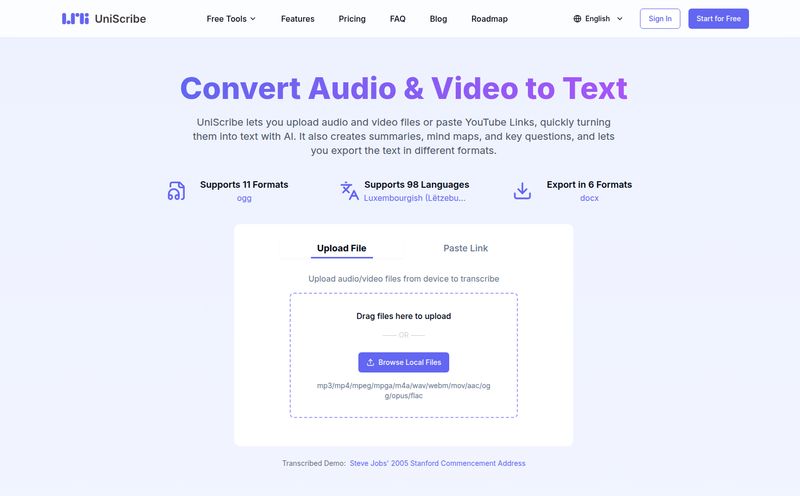I have a confession to make. I've spent entire weekends of my life doing nothing but creating Anki flashcards. I’m talking about bleary-eyed, coffee-fueled marathons, hunched over my laptop, copying and pasting from PDF lecture notes until the CTRL, C, and V keys were worn down to shiny nubs. I’d finish a 500-card deck on a Sunday night, feeling accomplished but also so utterly drained that the thought of actually studying the cards was exhausting.
If that sounds familiar, you get it. Anki is, without a doubt, one of the most powerful learning tools ever created. Spaced repetition is the real deal. But its biggest strength—its infinite customizability—is also its most glaring weakness. The barrier to entry isn't learning the software; it's the sheer, mind-numbing labor of manual card creation.
So, when I first heard about AnkiDecks, a platform that claims to use AI to generate flashcards for you, my inner skeptic raised a well-practiced eyebrow. Another AI tool promising to solve all my problems? Sure. But I'm also a glutton for any tech that promises to save me time. So I jumped in. And frankly, what I found was… surprisingly impressive.
So, What Exactly is AnkiDecks?
Let's get the basic pitch out of the way. AnkiDecks is an online tool that acts like a sous-chef for your brain. You provide the raw ingredients—a PDF of your professor's slides, a Word document of your notes, a chapter from an Epub textbook, or even just a link to a YouTube video—and it chops, dices, and preps them into ready-to-study Anki flashcards.
It’s clearly built with a few specific people in mind. Medical students, I'm looking at you. The thought of turning dense anatomy textbooks into usable flashcards is enough to make anyone shudder. Language learners are another huge group. The platform aims to take the grunt work out of vocabulary and grammar drilling. Basically, if you're facing a mountain of information and your primary tool for climbing it is Anki, AnkiDecks wants to be your sherpa.
My First Spin: The AnkiDecks Workflow
The user experience is pretty straightforward, which I appreciate. You’re not bogged down in a million settings. You create an account, hit the big "Create Flashcards" button, and choose your source. It feels less like operating complex machinery and more like using a fancy converter website.
From a Clunky PDF to Clean Flashcards
I started with the classic use case: a dense, 25-page PDF on SEO algorithms. I uploaded the file, and AnkiDecks gave me a few choices. Did I want simple Question & Answer cards? Or maybe Cloze deletions (the fill-in-the-blank style cards that I personally adore)? It even offers multiple choice. I picked Cloze, hit go, and waited a couple of minutes.
The result was a full deck of cards, with the AI identifying key terms and concepts and blanking them out. Was it perfect? No. A few of the generated cards were a bit clunky, and I’d still want to do a quick pass to edit them. But did it save me about an hour of tedious work? Absolutely. It’s like getting a first draft written for you; the painful part is over, and you can just focus on refining it.
The YouTube Magic Trick
This was the feature that really intrigued me. I grabbed a link to a fairly technical 15-minute video from a conference and fed it to the machine. AnkiDecks transcribed the entire video and then, just like with the PDF, turned the key points into a series of flashcards. This is just… cool. The ability to pull knowledge directly from video lectures without having to manually transcribe everything first is a massive unlock for students who learn better from watching than reading.

Visit AnkiDecks
The Real Star: AI Image Occlusion
Okay, let's talk about the killer app here. If you’ve ever had to learn anatomy, biology, engineering diagrams, or anything with complex visuals, you know the power of Image Occlusion. It’s a special card type in Anki where you can cover up labels on a diagram and then test yourself on them one by one.
Doing this manually in Anki is… a process. You have to draw each little box yourself. It takes forever. AnkiDecks automates this. You upload an image, like a diagram of the human skull, and its AI automatically identifies the labels and text, creating occlusion boxes over all of them. Click. Done. You get a set of cards, each one revealing a different label. This feature alone is almost worth the price of admission for a med student. It turns a 30-minute task into a 30-second one.
Studying Your Cards: Export or Stay In-House?
Once your deck is generated, you have two main options. This flexibility is a smart move on their part.
The Classic Anki Export for Purists
For die-hard Anki users (like me), you can simply export your new deck as an .apkg file. You download it, double-click it, and it imports directly into your desktop Anki application, complete with any images and formatting. It’s seamless. From there, it syncs to AnkiWeb and your mobile apps. Just a quick reminder, the official Anki app for iOS is a paid application, which is a separate cost from AnkiDecks itself, but the AnkiWeb and Android versions are free.
Studying Online with Their Built-in FSRS
Alternatively, you can study directly on the AnkiDecks website. They have their own online study interface, and they claim it uses the FSRS (Free Spaced Repetition Scheduler) algorithm. For those not deep in the Anki weeds, FSRS is a newer, more advanced scheduling algorithm that’s been making waves in the community for being more efficient than Anki's default scheduler. The fact that they built their platform with this in mind shows they are paying attention to what serious users want.
The All-Important Question: AnkiDecks Pricing
Alright, let's talk turkey. Nothing is ever truly free, right? AnkiDecks runs on a freemium model, and it's important to understand the tiers before you commit.
Here’s a quick breakdown of their annual plans, which offer the best value:
| Plan | Price (Billed Annually) | Key Limits Per Month |
|---|---|---|
| Free | $0 | 4 deck generations, 5 AI image occlusions, 4 pages/doc |
| Pro (Most Popular) | $5 /month | 50 deck generations, 100 AI image occlusions, 100 pages/doc |
| Ultimate | $12 /month | 200 deck generations, 1000 AI image occlusions, 100 pages/doc |
Note: They also offer monthly billing options which are slightly more expensive per month.
Is the Free Plan Actually Usable?
In my opinion, the free plan is best thought of as a trial. Four deck generations and only five image occlusions per month is very restrictive. You’ll burn through that just testing the features on a single lecture. It’s enough to see if you like the tool, but not enough for any serious, ongoing study.
Pro vs. Ultimate
For the vast majority of students, the Pro plan is the sweet spot. 50 decks and 100 image occlusions a month is more than enough to handle a heavy course load. The Ultimate plan is really for the absolute power users—maybe someone in their final year of med school or a PhD candidate who is generating massive volumes of cards daily. For most undergrads or casual learners, Pro is the way to go.
The Good, The Bad, and The AI
What I Absolutely Love
The time savings are real. This isn't just marketing fluff. Turning a 2-hour manual card-creation slog into a 10-minute review process is a legitimate game-changer. It shifts your energy from tedious prep to active learning. The Image Occlusion and YouTube features are standouts, solving genuine pain points for students. And the multi-language support is a fantastic touch, making it a valuable tool for polyglots and language learners.
Where It Could Improve
Let's be real, the AI isn't a mind-reader. It's a powerful assistant, not a replacement for your own brain. You still need to review the generated cards for accuracy and relevance. Sometimes it picks an awkward sentence for a Cloze deletion, or misses the main point of a paragraph. Its a small price to pay for the speed, but don't just blindly import the decks and assume they're perfect. The free plan is also, as mentioned, quite limiting. I get why, AI processing costs money, but users should be aware they’ll likely need to upgrade for regular use.
Final Verdict: Is AnkiDecks Worth Your Time and Money?
After spending some quality time with it, my initial skepticism has mostly melted away. AnkiDecks isn't a magic wand, but it is an incredibly powerful lever. It helps you overcome the single biggest hurdle to effective spaced repetition: the activation energy required to create your materials.
So, who is it for?
- Medical Students & STEM Majors: Yes. 100%. The time you save with image occlusion and processing dense texts will pay for the subscription in the first week. Don't even hesitate.
- Language Learners: A very strong yes. The ability to quickly create cards from articles, books, and videos, plus the translation features, is fantastic for immersion.
- University Students (Humanities, Law, etc.): Definitely. If your life revolves around PDF readings and lecture slides, this will streamline your study process significantly.
If you're a casual Anki user who only makes a few dozen cards a month, you can probably stick to doing it manually. But if you are a serious student who views Anki as a cornerstone of your learning strategy, then yes, AnkiDecks is absolutely worth the modest investment. You're not just buying a piece of software; you're buying back your time. And for a student, time is the most valuable resource there is.
Frequently Asked Questions about AnkiDecks
- 1. Can I really use AnkiDecks for free?
- Yes, there is a free plan. However, it's quite limited (e.g., 4 deck generations per month) and is best used as a trial to see if you like the platform's workflow before upgrading to a paid plan.
- 2. What file types does AnkiDecks support?
- AnkiDecks can generate flashcards from a wide range of formats, including PDF, PowerPoint (PPTX), Word documents (DOCX), Epub files, and plain text. It can also generate cards directly from a YouTube link.
- 3. Is AI-generated flashcards as good as making them myself?
- This is a great question. The act of manually creating a card can help with learning. However, the AI does the heavy lifting, allowing you to create hundreds of cards in minutes. The best approach is a hybrid one: let the AI do the initial creation, then spend a few minutes quickly reviewing and editing the cards. This still saves a massive amount of time while ensuring the cards are tailored to your needs.
- 4. Do I need the official Anki software to use AnkiDecks?
- Not necessarily. You have the option to export your decks and use them in the traditional Anki ecosystem (Desktop, AnkiWeb, AnkiMobile). Alternatively, you can study the cards directly on the AnkiDecks website, which has its own built-in spaced repetition system.
- 5. How does the AI image occlusion work?
- You upload an image with labels (like a biological diagram or a map). The AI scans the image, identifies the text elements, and automatically creates individual flashcards that blank out each label, allowing you to test your recall for each part of the diagram. It's one of its most powerful features for visual learners.
Conclusion
Look, the grind of being a student isn't going away. There will always be more to learn, more to read, and more to memorize. Tools like Anki have given us a better system for learning, but they haven't always solved the workload problem. AnkiDecks feels like the next logical step—it automates the most laborious part of the process, freeing up your cognitive resources for what actually matters: learning the material. It successfully bridges the gap between your source material and your study routine, and in my book, that's a huge win.



